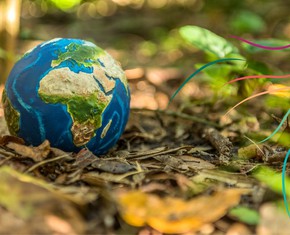The views expressed in our content reflect individual perspectives and do not represent the authoritative views of the Baha'i Faith.
To understand addiction, we need to understand pain—and that means understanding we’re all opioid addicts, in a weird way.
Surprised? Don’t be—normal human bodies have at least four organically-occurring opioid receptors; and we each produce endogenous opioids called endorphins and encephalins. Actually, the word endorphins is a simple contraction of the term endogenous morphines, which literally means “a morphine-like substance that originates within the body.”
In other words, we all make our own natural opioids.
 Why? Well, we know that our endorphins and encephalins naturally decrease pain and discomfort. They’re built-in, highly effective pain relievers. We can increase their production in our own bodies with a vigorous exercise routine—and by going to a comedy club or watching a funny movie. Seriously. If you’ve ever heard the phrase “runner’s high,” you already understand something about how exercise releases endorphins into the bloodstream. Several studies have also shown that laughter stimulates the body’s endorphin production. One comedian calls extended, hearty laughter “jogging for the insides,” and it turns out he’s scientifically correct.
Why? Well, we know that our endorphins and encephalins naturally decrease pain and discomfort. They’re built-in, highly effective pain relievers. We can increase their production in our own bodies with a vigorous exercise routine—and by going to a comedy club or watching a funny movie. Seriously. If you’ve ever heard the phrase “runner’s high,” you already understand something about how exercise releases endorphins into the bloodstream. Several studies have also shown that laughter stimulates the body’s endorphin production. One comedian calls extended, hearty laughter “jogging for the insides,” and it turns out he’s scientifically correct.
Here’s another amazing factoid: endorphins also mediate complex social behaviors in humans—and scientists believe they’re heavily involved in helping us form stable, emotionally committed relationships. Love, in other words, may be an endorphin-related emotion. Remember how high you felt when you first fell in love? Those were your endorphins, rushing to your brain and making you feel giddy and gobsmacked.
With that in mind, you can probably start to understand why the opioids like heroin and the synthetics that mimic its effects are so addictive:
Opioids include drugs such as OxyContin and Vicodin that are mostly prescribed for the treatment of moderate to severe pain. They act by attaching to specific proteins called opioid receptors, which are found on nerve cells in the brain, spinal cord, gastrointestinal tract, and other organs in the body. When these drugs attach to their receptors, they reduce the perception of pain and can produce a sense of well-being; however, they can also produce drowsiness, mental confusion, nausea, and constipation. The effects of opioids are typically mediated by specific subtypes of opioid receptors (mu, delta, and kappa) that are activated by the body’s own (endogenous) opioid chemicals (endorphins, encephalins). With repeated administration of opioid drugs (prescription or heroin), the production of endogenous opioids is inhibited, which accounts in part for the discomfort that ensues when the drugs are discontinued (i.e., withdrawal). – America’s Addiction to Opioids: Heroin and Prescription Drug Abuse, The National Institute for Drug Abuse, May 14, 2014.
For some reason science and medicine don’t yet fully understand, habitually taking any opioid drug, whether from a physician’s prescription or a street dealer, gradually reduces “the production of endogenous opioids.” That means the body seems to inhibit, lower and then stop its production of its own endorphins when it senses the presence of other opioid compounds in the bloodstream. That fact alone makes recovery from long-term opiate addiction very, very difficult. Because opioids powerfully mimic a natural substance, they literally subvert and eventually destroy the body’s innate capacity to decrease pain, to feel for others and even to love.
The Baha’i teachings pointed all of this out long before the science confirmed it:
… capacity is of two kinds: innate and acquired. The innate capacity, which is the creation of God, is wholly and entirely good—in the innate nature there is no evil. The acquired capacity, however, can become the cause of evil. For example, God has created all men in such a fashion, and has given them such a capacity and disposition, that they are benefited by sugar and honey and are harmed or killed by poison. This is an innate capacity and disposition that God has bestowed equally upon all men. But man may begin little by little to take poison by ingesting a small quantity every day and gradually increasing it until he reaches the point where he would perish if he were not to consume several grams of opium every day, where his innate capacities are completely subverted. Consider how the innate capacity and disposition can be so completely changed, through variations of habit and training, as to be entirely perverted. – Abdu’l-Baha, Some Answered Questions, newly revised edition, pp. 247-248.
Of course, we all know that heroin and the synthetic opioids are poison. Opiates kill people every day. The strongest synthetic opioid, fentanyl, was originally developed as a powerful anesthetic and an elephant tranquilizer, and is, in some formulations, 10,000 times more potent than morphine. Even in tiny airborne doses or absorbed through the skin, it can stop human respiration. Police departments now routinely issue respirators and protective clothing to officers who may come in contact with fentanyl during drug busts.
The musician Prince died from an accidental fentanyl overdose in 2016—he unknowingly took counterfeit, mislabeled pain pills that contained minute amounts of fentanyl. Canada declared a public health crisis in 2015 because of fentanyl overdose deaths—at least two per day in British Columbia alone. Several European countries have experienced fentanyl overdose epidemics. Because it can be cheaply manufactured, fentanyl has now found its way into many different street drugs—heroin, cocaine, MDMA or ecstasy, and counterfeit prescription pills like oxycodone and hydrocodone. Often, when heroin and other drug users die from overdoses, fentanyl is the hidden culprit.
We have entered an era in human history when our drugs, prescribed or not, have become deadly.
So what does that mean for drug policy? Should we conduct a “war on drugs” by attempting to eliminate the supply; or should we treat addiction as a purely medical issue and de-criminalize it?
In the next essay in this series, we’ll explore some of the answers to those important questions.
You May Also Like
Comments

















You are suggesting here that people who use opiates eventually lose the capacity to feel for others and even to love? I'm sorry but that is an utterly preposterous notion and does not follow from the claim that long term use of opiates can downregulate endorphin production.
I like Abdu'l-Baha's observation,
and in "Some Answered Questions"
he described future healing that
doesn't generally need chemical
formulations; changes in the amount
and ratio of basic nutrients, and their effect on those internally-created substances David is talking
about, would be a major factor in
health, and so would spiritual state,
attitude, etc.